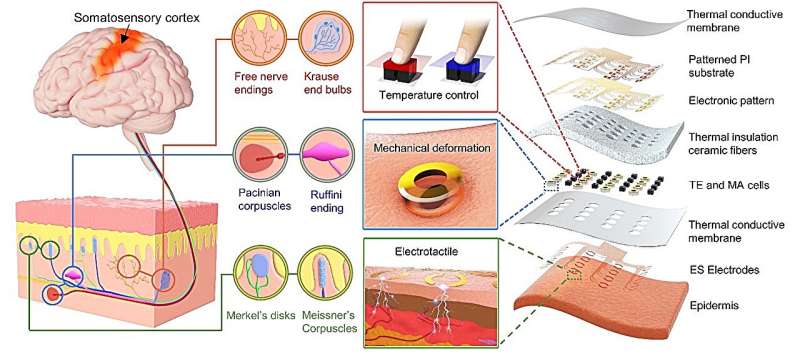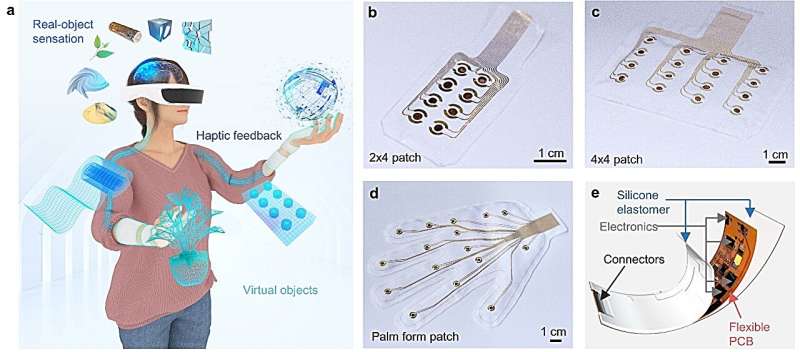December 21, 2023 feature
This article has been reviewed according to Science X's editorial process and policies. Editors have highlighted the following attributes while ensuring the content's credibility:
fact-checked
peer-reviewed publication
trusted source
proofread
A skin-integrated multimodal haptic interface to produce immersive tactile experiences

Virtual reality (VR) and augmented reality (AR) technologies have become increasingly advanced over the past decade or so, enabling highly engaging gaming experiences and new forms of media entertainment. Yet there is still significant room to improvement, particularly in terms of artificially stimulating other senses beyond vision and hearing.
Researchers at City University of Hong Kong and other institutes in China have been trying to develop new interfaces that would allow end-users to closely connect with virtual environments through their sense of touch. In a recent paper, published in Nature Electronics, they introduced a new haptic interface that delivers multi-dimensional tactile signals directly on the skin, eliciting realistic sensations that could further enhance virtual experiences.
"Currently, global research on flexible electronics primarily focuses on the development of flexible sensors, while the investigation into flexible feedback techniques remains limited," Ya Huang, co-author of the paper, told Tech Xplore.
"Recognizing the lack of information feedback in flexible electronic technology, Prof. Yu integrated flexible mechanical feedback actuators using flexible electronic technology, which made significant strides in this area. This innovation, first presented in a Nature paper published in 2019, has found applications in areas such as social media, gaming, control and feedback of prosthetics, as well as various biomedical fields."
Prof. Xinge Yu, working at City University of Hong Kong and Hong Kong Science Park has been focusing his recent work on the development of haptic interfaces based on flexible electronics. In 2022, his research group published a paper in Nature Machine Intelligence, introducing a new wireless electrostimulation haptic interface. This paper, however, primarily focused on the overall creation of haptic feedback using this interface, rather than on the generation of diverse immersive tactile sensations.
"In our recent paper published, we addressed this gap by designing a haptic feedback interface with multidimensional stimulation modes," Huang explained. "This interface selectively stimulates different receptors, thereby reproducing tactile sensations that correspond to various textures."
The human body can perceive a wide range of tactile information when it physically encounters different objects or surfaces. This capability is supported by biological mechanisms that allow humans to process numerous types of tactile information.
"These multidimensional signals work in harmony, providing us with a diverse and vivid tactile experience," Huang said. "The provision of a feedback interface capable of delivering multi-dimensional tactile signals plays a crucial role in maximizing the effective reproduction of human touch sensation in VR/AR. Our device offers a significant advantage by integrating three feedback modes into a single skin-integrated interface."

Huang and his colleagues introduced a new activation principle that allows their haptic system to stimulate different sensory receptors and sensation nerves in the human body. If combined with VR or AR technology, this could ultimately enable even more realistic and immersive experiences, enriched by tactile sensations.
Currently, technology designed to produce haptic feedback is branching out in two primary directions. The first of these focuses on electrical stimulation, while the second produces tactile signals via mechanical actuation.
"The most difficult aspect in electrical stimulation primarily focuses on biological research, aiming to accurately activate nerves to generate real tactile sensations within the human body," Huang explained.
"Nonetheless, this area offers vast potential for theoretical exploration and further advancements. On the other hand, mechanical actuation achieves haptic feedback by designing deformable interactive interfaces or devices that replicate the skin's surface deformation when interacting with real objects. The key challenge here lies in the design of the mechanical structure to accurately mimic the tactile experience."
The recent work by Huang and his colleagues effectively bridges the gap between these two distinct approaches to producing haptic feedback. This is achieved via the introduction of a principle that delineates the selective stimulation of different touch receptors, based on the rules underpinning the distribution of these receptors and the activation of sensory nerves in the human body.
"By combining the advantages of both electrical stimulation and mechanical actuations, we have been able to achieve more diverse and immersive tactile feedback effects," Huang said. "Our approach breaks down the barriers that previously separated these two paths, allowing for the integration of multiple feedback modes within a single device. This experiment rules and innovation opens new possibilities for providing users with richer and more realistic touch experiences."
The skin-integrated multimodal haptic interface developed by this team of researchers is a great contribution to the research field focusing on the development of haptic technology. In the future, this work could open interesting new possibilities for the creation of highly immersive VR content also accompanied by realistic tactile sensations.
"There is still a lot of room for development in the field of haptic feedback," Huang added. "For the feedback interface itself, various areas of research, such as material synthesis, mechanical structure optimization, and neuro electrophysiology, are closely intertwined with the design principles and fabrication of feedback interface. When considering future applications, several aspects, including VR software, machine algorithms, data processing, and even user psychology, present valuable avenues for exploration."
More information: Ya Huang et al, A skin-integrated multimodal haptic interface for immersive tactile feedback, Nature Electronics (2023). DOI: 10.1038/s41928-023-01074-z.
© 2023 Science X Network





















